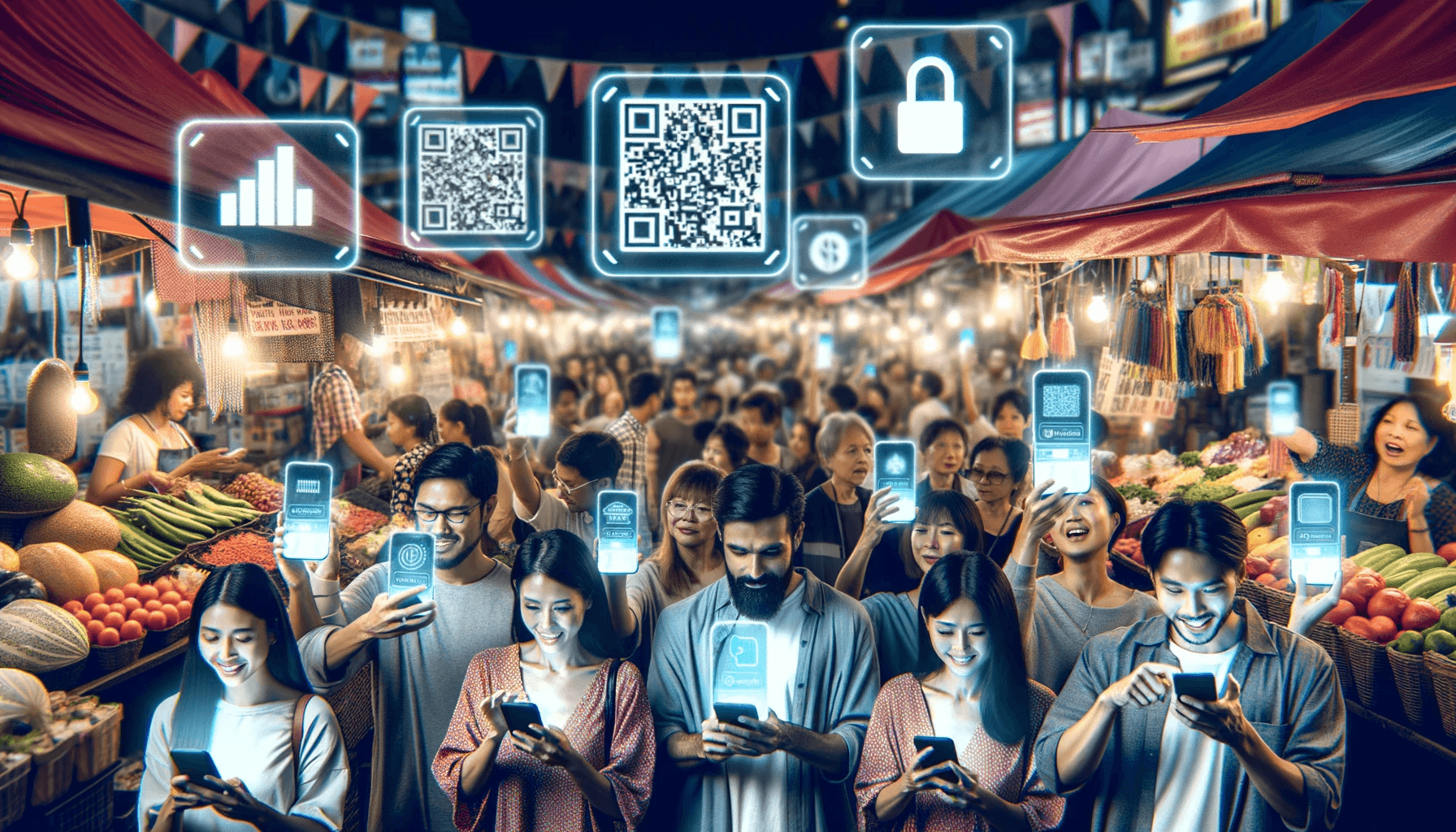“
The evolution of digital wallets and payment apps has revolutionized the way we make transactions and manage our finances in the digital age. Digital wallets, as defined and explored in the article, are virtual wallets that securely store payment information and enable users to make electronic transactions through their smartphones or other mobile devices. They have undergone significant advancements and transformations over time, encompassing various types of digital wallets that cater to different user needs.
The rise of digital wallets and payment apps can be attributed to early innovations and the emergence of key players in the market. Early adopters introduced the concept of digital wallets, and with advancements in technology, major players like Apple Pay, Google Pay, and PayPal have gained prominence and transformed the landscape of digital payments.
Digital wallets offer a range of features and functionalities that enhance convenience and efficiency in transactions. They enable contactless payments, integration with loyalty programs, and peer-to-peer payments, making transactions quick, seamless, and hassle-free.
Using digital wallets and payment apps brings numerous benefits, including convenience, efficiency, enhanced security, and personal financial management. Users can enjoy streamlined payment experiences, improved protection against fraud, and better control over their finances through the features and tools provided by these platforms.
However, challenges and concerns exist with the adoption of digital wallets. Security and fraud risks pose a threat to users’ financial information, and privacy concerns arise regarding the collection and use of personal data. Compatibility issues and the need for widespread adoption remain hurdles in the widespread use and acceptance of digital wallets.
Looking towards the future, the article explores the potential impact of emerging technologies on digital wallets and payment apps. The integration of technologies like blockchain and the Internet of Things (IoT) could further enhance the security and functionality of these platforms. Collaboration among industry players and integration with other digital services are also expected to shape the future of digital wallets and payment apps, creating a seamless experience for users.
The evolution of digital wallets and payment apps has transformed the way we handle financial transactions, offering convenience, security, and streamlined experiences. By understanding the history, features, benefits, challenges, and future possibilities of these digital payment solutions, users can make informed decisions about adopting and utilizing digital wallets in their daily lives.
“
Key takeaways:
- Digital wallets and payment apps have evolved significantly, offering convenience and efficiency to users.
- There are various types of digital wallets available, catering to different consumer needs and preferences.
- The rise of digital wallets has led to the integration of innovative features like contactless payments, loyalty program integration, and peer-to-peer payments.
The Evolution of Digital Wallets and Payment Apps
Digital wallets and payment apps have seen significant progress since their inception. Initially, their usage was limited to basic online transactions. However, with the continuous advancements in technology, their capabilities have expanded. Presently, digital wallets offer users the convenience of storing multiple payment methods, making contactless payments, transferring money to friends and family, and even conducting purchases through their smartphones. The security measures surrounding digital wallets have also undergone improvement, resulting in safer and more secure transactions. The transformation of digital wallets and payment apps has undoubtedly revolutionized the way we manage our finances, providing us with unparalleled convenience and ease of use.
Let me illustrate this with an example involving Jane, a busy professional. One day, while rushing to catch her flight, she suddenly realized that she had left her wallet at home. Frantically, she remembered that she had her mobile payment app installed on her phone. With just a few taps, she effortlessly purchased her ticket and paid for her airport parking using her digital wallet. Thanks to the evolution of digital wallets and payment apps, Jane successfully made her flight without any hassle. This incident perfectly exemplifies how these technologies have truly transformed the way we conduct transactions in our everyday lives.
What are Digital Wallets?
Wondering what digital wallets are all about? Get ready to dive into the world of convenient and secure payment methods. In this section, we’ll unravel the mysteries behind digital wallets by exploring their definition, purpose, and the various types available. Brace yourself for an enlightening journey into the realm of cashless transactions and seamless financial experiences. Say goodbye to bulky wallets and join the digital revolution!
Definition and Purpose
A digital wallet, by definition, is a virtual wallet designed to store and manage payment information on electronic devices. Its purpose is to offer a convenient and secure method for conducting online and offline transactions. Digital wallets serve various functions, including facilitating mobile payments, storing loyalty cards and tickets, and enabling money transfers to friends and family. The advantage of digital wallets is that they eliminate the need to carry physical credit cards and cash, streamlining transactions to be quick and hassle-free. When selecting a digital wallet, it is advisable to consider options that prioritize strong security measures, a user-friendly interface, and compatibility with both devices and preferred payment methods.
Types of Digital Wallets
Different types of digital wallets are available, each catering to different user preferences and security measures. Here is a table outlining various types of digital wallets:
| Type | Description |
|---|---|
| Mobile Wallets | Stored on a smartphone app, accessible for making payments in physical stores or online. Examples include Apple Pay and Google Pay. |
| Online Wallets | Web-based wallets used for online transactions. Popular online wallets include PayPal and Amazon Pay. |
| Hardware Wallets | Physical devices that securely store cryptocurrency keys. Ledger and Trezor are renowned hardware wallet brands. |
| Software Wallets | Wallets installed on a computer or laptop. These include Electrum for Bitcoin and Exodus for multiple cryptocurrencies. |
| Paper Wallets | Printed or written records containing public and private keys. Often used to securely store offline cryptocurrencies. |
| Contactless Cards | Physical cards with embedded NFC (near-field communication) technology for contactless payments. Examples include Apple Card and Samsung Pay. |
These distinct types of digital wallets cater to diverse needs, giving users the option to choose the one that best fits their lifestyle and preferences.
The Rise of Digital Wallets and Payment Apps
As digital technology continues to revolutionize the way we handle transactions, one thing is clear: the rise of digital wallets and payment apps is changing the game. From the early days of innovation to the present-day dominance of key players in the market, this section dives into the exciting evolution of digital wallets and payment apps. Get ready to uncover the fascinating milestones, trends, and market dynamics that have shaped this transformative industry.
Early Innovations
In the development of digital wallets paved the way for the seamless and convenient payment solutions we have today. Here is a table that highlights some key early innovations in the digital wallet industry:
| Early Innovations | Description |
|---|---|
| Smart Card Technology | The introduction of smart cards enabled secure storage of payment information. |
| Mobile Wallets | The emergence of mobile wallets allowed users to make payments using their smartphones. |
| NFC Technology | Near Field Communication (NFC) technology enabled contactless payments through smartphones. |
| QR Code Payments | QR code-based payments revolutionized the ease of making transactions by scanning codes. |
These early innovations laid the foundation for the digital payment revolution, paving the way for the convenient and secure payment apps and digital wallets we have today.
Key Players in the Market
When it comes to the key players in the digital wallet market, several companies have emerged as industry leaders. Here is a snapshot of some of the prominent key players in the market:
| Company | Description |
|---|---|
| Apple Pay | A mobile payment and digital wallet service developed by Apple Inc. |
| Google Pay | A digital wallet platform and online payment system developed by Google. |
| Samsung Pay | A mobile payment and digital wallet service developed by Samsung Electronics. |
| PayPal | A widely used online payment system that also provides digital wallet functionality. |
| Venmo | A mobile payment service owned by PayPal, known for its social payment features. |
| Alipay | An e-wallet service based in China, providing various financial services. |
| WeChat Pay | A digital wallet service embedded within the WeChat app, popular in China. |
| Paytm | An Indian digital wallet and payment service platform with a significant user base. |
| Square Cash (Cash App) | A peer-to-peer mobile payment service offered by Square, Inc. |
These prominent key players in the market have revolutionized the way we make payments, offering convenience and secure transactions. As the market continues to evolve, we can expect to see more players entering the digital wallet arena, further enhancing the options available to consumers.
Features and Functionalities of Digital Wallets
In today’s digital age, our wallets have transcended physical boundaries and evolved into powerful digital tools. Join me as we explore the fascinating features and functionalities of digital wallets. From the convenience of contactless payments to the seamless integration with loyalty programs, and the ease of peer-to-peer payments, this section will unveil the exciting world of digital wallets and the incredible ways they are transforming the way we handle our finances. Get ready to step into the future of payment solutions!
Contactless Payments
Contactless payments are a convenient and secure way to make transactions without physical contact. This technology allows users to complete purchases by simply waving their mobile devices or contactless cards near a payment terminal. With contactless payments, you can reduce transaction times and avoid the need to handle cash or input PINs. Many digital wallets, such as Apple Pay, Google Pay, and Samsung Pay, offer contactless payment capabilities, making it easier for users to make purchases on the go. As contactless payment technology continues to evolve, it promises to transform the way we pay for goods and services. Happy tapping!
Integration with Loyalty Programs
Integrating digital wallets with loyalty programs offers several advantages, especially when it comes to integration with loyalty programs.
- Convenience: Users can conveniently access and manage their loyalty points within the digital wallet app, thanks to the integration with loyalty programs.
- Streamlined experience: Combining payment and loyalty information in one app simplifies the user experience during checkout and enhances the integration with loyalty programs.
- Increased engagement: Loyalty program integration encourages customers to use their digital wallets more frequently, fostering stronger brand loyalty through the integration with loyalty programs.
- Personalized offers: Digital wallets can leverage user data to provide targeted promotions and rewards based on shopping habits and preferences, thanks to the integration with loyalty programs.
To optimize this integration, businesses should ensure seamless syncing between loyalty systems and digital wallet apps, ensuring smooth integration with loyalty programs. Offering exclusive rewards for digital wallet users can incentivize adoption and usage of the integration with loyalty programs.
Peer-to-Peer Payments
Peer-to-Peer Payments
Peer-to-peer payments, also known as P2P payments, allow individuals to send and receive money directly from their personal electronic devices. This convenient payment method eliminates the need for cash or checks and is often facilitated through digital wallet apps. Here are some key points to consider when using P2P payments:
- Security: Ensure the P2P platform you choose has robust security measures in place to protect your financial information.
- Convenience: P2P payments offer instant money transfers, making it quick and easy to split bills, pay friends back, or make purchases.
- Cost: Many P2P payment services are free to use, although some may charge fees for certain transactions or additional services.
- Compatibility: Check that the P2P payment app you select is compatible with both yours and the recipient’s devices and bank accounts.
- Popular platforms: Some popular P2P payment apps include Venmo, PayPal, Cash App, and Zelle.
The Benefits of Using Digital Wallets and Payment Apps
Discover a world of convenience and possibilities with digital wallets and payment apps. Get ready to experience the benefits that come with using these innovative solutions. From enhanced security to streamlined personal financial management, we’ll explore how digital wallets and payment apps revolutionize the way we handle transactions. Say goodbye to the hassle of carrying cash and hello to a new era of seamless and efficient financial interactions. Are you ready to unlock the power of digital payment solutions? Let’s dive in!
Convenience and Efficiency
- Digital wallets offer convenience and efficiency in various ways, making them a popular choice for modern consumers.
- Seamless transactions: With digital wallets, you can experience the convenience and efficiency of making quick and hassle-free payments by simply tapping your smartphone or scanning a QR code.
- Easy access to funds: Digital wallets allow you to enjoy the convenience and efficiency of storing multiple payment methods in one place, eliminating the need to carry multiple cards or cash.
- Organized expenses: Many digital wallets offer features that help you track your spending and manage your finances more effectively, providing convenience and efficiency.
- Time-saving: With digital wallets, you can skip the hassle of manual data entry for each transaction, saving you time at the checkout and enhancing convenience and efficiency.
Pro-tip: Set reminders to track your expenses regularly and ensure that you stay within your budget while enjoying the convenience and efficiency of digital wallets.
Enhanced Security
Enhanced security is an imperative aspect to consider when utilizing digital wallets and payment apps. These platforms employ various measures to safeguard users’ sensitive information and transactions. Biometric authentication, encryption technology, and tokenization are just a few of the features that contribute to enhancing security. Biometric authentication, such as fingerprint or facial recognition, adds an additional layer of protection to the users. Encryption technology ensures that personal and financial data is securely transmitted. Tokenization replaces sensitive information with unique tokens, minimizing the risk of data breaches. By prioritizing enhanced security features, digital wallets and payment apps offer users peace of mind and effectively guard against unauthorized access and fraudulent activities.
Personal Financial Management
Personal financial management is a crucial consideration when utilizing digital wallets and payment apps. These platforms offer various features that enable users to effectively monitor and control their spending, establish budgets, and evaluate their financial status. By seamlessly connecting bank accounts and credit cards, users can effortlessly access their transaction records and analyze their expenditures. The inclusion of budgeting tools allows for the provision of alerts and notifications, keeping users on target with their financial objectives. Some digital wallets even provide investment management features, furnishing invaluable personalized insights and recommendations based on individual spending habits. With these capabilities, users are empowered to seize command of their financial well-being and make informed decisions.
Challenges and Concerns with Digital Wallets
Digital wallets and payment apps have revolutionized the way we handle transactions, but with such convenience comes important challenges and concerns. In this section, we’ll dive into the potential risks and vulnerabilities associated with digital wallets. From security and fraud risks to privacy concerns, we’ll explore the implications of these issues. We’ll touch upon the adoption and compatibility hurdles that may impact the widespread use of digital wallets. Stay informed and discover the key aspects to consider when embracing this modern payment solution.
Security and Fraud Risks
When it comes to digital wallets and payment apps, security and fraud risks are paramount considerations. These risks encompass unauthorized access to personal information or financial data, deceitful transactions, and the potential for identity theft. To effectively address these concerns, it is crucial to select a digital wallet provider of high repute that implements robust security measures, including encryption and two-factor authentication. Additionally, enhancing security can be achieved by regularly updating the digital wallet app and employing strong, unique passwords. Vigilantly monitoring transactions and staying alert to any suspicious activities are also effective in detecting and preventing fraud.
In an actual incident, a woman experienced the unfortunate consequences of digital wallet fraud where her account was compromised, leading to the theft of her funds. However, swift action taken by both the woman and the digital wallet company proved instrumental in securing her account and successfully refunding the stolen funds, thus resolving the issue. This occurrence underscores the significance of promptly reporting any suspicious activity and underscores the crucial role that digital wallet providers play in addressing security concerns.
Privacy Concerns
Privacy concerns are a significant consideration when it comes to digital wallets and payment apps. Users have legitimate worries about the security of their personal information and financial transactions. They are understandably concerned about data breaches, identity theft, and unauthorized access to their accounts. To address and alleviate these concerns, digital wallet providers must prioritize and implement robust security measures, including encryption and multi-factor authentication. It is of utmost importance for users to carefully review the privacy policies and terms of service of the digital wallet or payment app they choose to ensure that their valuable data is adequately protected. As the use of digital wallets continues to surge, privacy concerns will undoubtedly remain a critical and influential factor in their widespread adoption and sustained usage.
In 2014, one of the world’s largest digital payment processing companies experienced a devastating data breach, compromising the personal information of millions of users. This unfortunate incident served as a serious wake-up call, shedding light on the paramount significance of privacy concerns when it comes to digital wallets and payment apps. Consequently, the company faced severe backlash and legal repercussions, compelling the entire industry to prioritize and enhance data security and privacy measures. Subsequently, digital wallet providers have significantly amplified their efforts to protect user privacy, ensuring the seamless and secure utilization of their platforms.
Adoption and Compatibility Issues
Adoption and compatibility issues are crucial considerations in the realm of digital wallets and payment apps. These challenges encompass a limited merchant acceptance, compatibility complexities with various operating systems, and the necessity for NFC-enabled devices. Although digital wallets are experiencing greater prevalence, their universal adoption still remains incomplete. To prevent any inconvenience, users must ensure that their chosen digital wallet is compatible with their devices and widely accepted by most merchants. Consequently, compatibility issues might emerge when using different payment apps, mandating users to install multiple apps on their devices.
The Future of Digital Wallets and Payment Apps
As the world rapidly shifts towards digital transactions, the future of digital wallets and payment apps holds immense potential. In this thrilling section, we’ll explore two key aspects that will shape this future. We’ll investigate the impact of emerging technologies, unlocking exciting possibilities for seamless transactions and enhanced security. We’ll delve into the power of collaboration and integration, revealing how partnerships and unified platforms can revolutionize the way we handle our finances. Get ready for an eye-opening journey into the future of digital wallets and payment apps!
The Impact of Emerging Technologies
Emerging technologies have had a significant impact on the evolution of digital wallets and payment apps. With advancements like biometric authentication, artificial intelligence, and blockchain, digital wallets have become even more secure and convenient. The impact of these emerging technologies can be seen in various aspects of digital wallets and payment apps.
Firstly, biometric authentication, including fingerprints or facial recognition, plays a crucial role in enhancing security. By utilizing biometric data, digital wallets ensure that only authorized users can access them, preventing unauthorized access and potential fraud. This added layer of security is especially important as digital transactions continue to grow in popularity.
Additionally, artificial intelligence algorithms have revolutionized the way fraudulent transactions are detected and prevented. Through continuous learning and pattern recognition, AI systems can identify suspicious activities, alerting users and service providers to potential risks. This proactive approach significantly improves overall security and helps build trust among users.
Furthermore, blockchain technology has driven faster and more transparent transactions within digital wallets. By removing the need for intermediaries, blockchain enables direct peer-to-peer transactions, reducing processing time and costs. The decentralized nature of blockchain also enhances security by creating an immutable record of transactions, making it difficult for malicious actors to manipulate or tamper with data.
As these emerging technologies continue to develop and mature, digital wallets and payment apps will become even more efficient, secure, and user-friendly. Users can expect enhanced security features, streamlined processes, and improved user experiences.
A striking fact that highlights the impact of emerging technologies is that the use of biometric authentication in digital wallets is estimated to reach a global market value of $7.7 billion by 2024. This demonstrates the growing importance and adoption of biometric authentication as a secure method for accessing digital wallets.
Collaboration and Integration
Collaboration and integration play vital roles in the development of digital wallets and payment apps. Digital wallet providers often collaborate with banks, merchants, and technology companies to offer users a seamless and comprehensive experience. This collaboration allows for the integration of multiple services and features within the digital wallet platform, enhancing convenience and value for users. Additionally, digital wallets are integrating with various technologies and platforms, including social media, e-commerce sites, and transportation systems. This integration expands the functionality and versatility of digital wallets, enabling users to make payments and access wallet features in different contexts. The history of collaboration and integration in digital wallets has paved the way for an interconnected and user-friendly payment ecosystem, where users can easily manage their finances and conduct transactions in diverse settings.
Frequently Asked Questions
1. When was the first digital wallet-like solution introduced and what was its purpose?
The first digital wallet-like solution was introduced by Coca-Cola in 1997 with vending machines that accepted payment by text message.
2. What were the main features of the early digital wallets?
The early digital wallets, such as PayPal launched in 1999, focused on accepting fiat money and facilitating electronic money transfer services.
3. How have digital wallets evolved over time?
Digital wallets have evolved to offer mobile phone payment options like Alibaba’s Alipay and Kenya’s M-Pesa in 2003 and 2007 respectively. They have also incorporated technologies like near-field communication (NFC) for contactless payments.
4. What are some innovative features offered by digital wallets?
Modern digital wallets offer innovative features such as budgeting, expense tracking, investment options, and the ability to send money directly to friends and relatives.
5. How have digital wallets impacted businesses?
Digital wallets have simplified the checkout process for businesses by integrating payment gateways into mobile apps, expanding their customer base and enabling acceptance of payments from customers worldwide.
6. What is the future outlook for digital wallets?
The future of digital wallets is expected to involve increased user uptake across various industries, leading to the development of “super wallets” containing not just financial accounts but also personal information. Technologies like blockchain and cryptocurrencies have the potential to enhance digital wallet functionalities.






